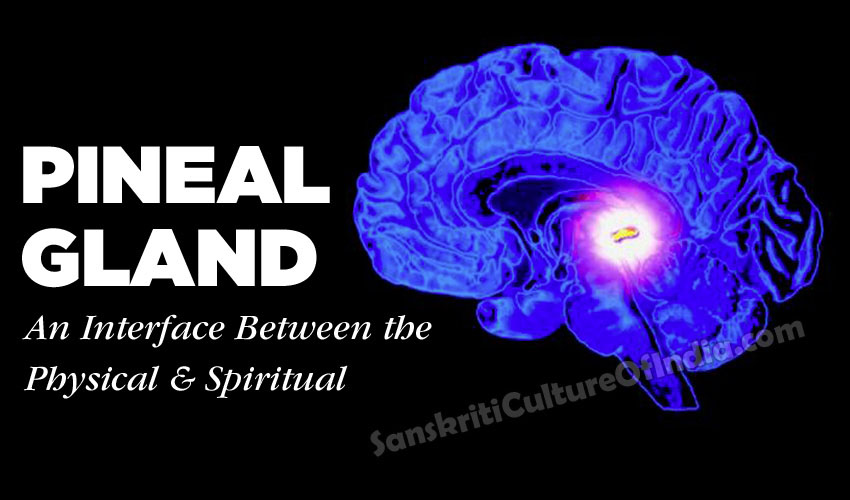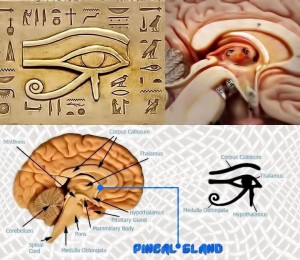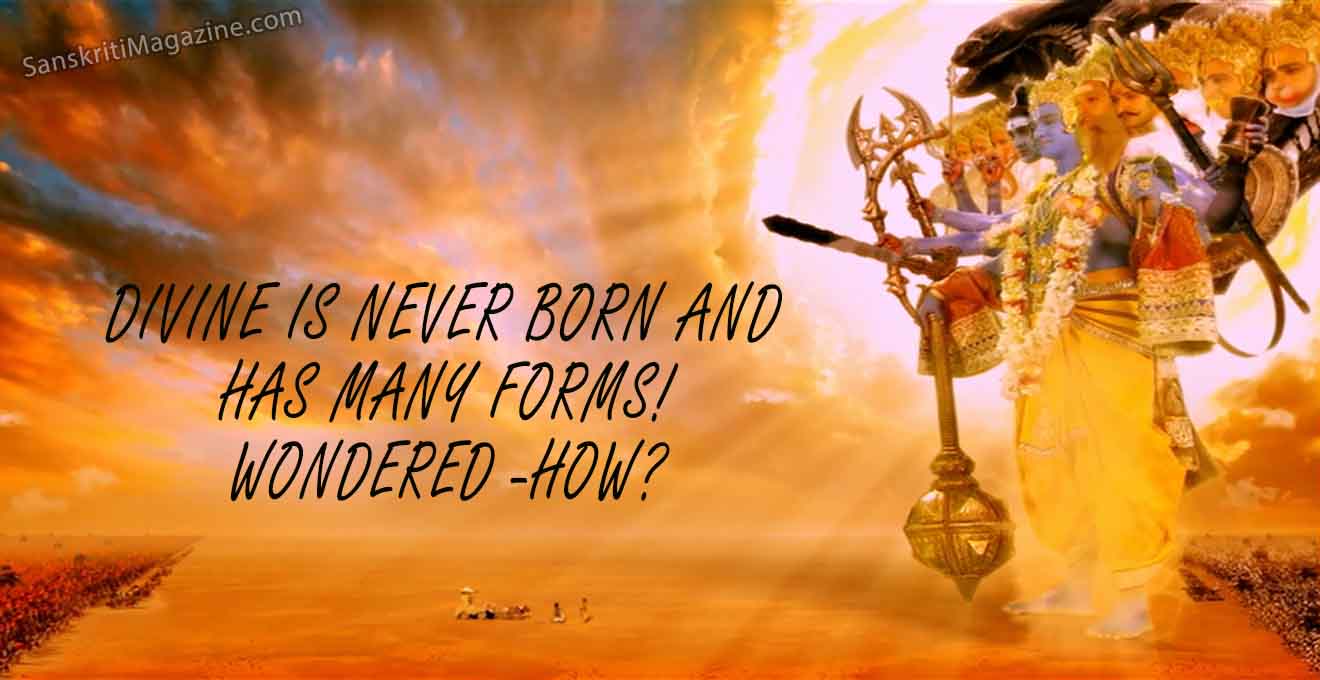The pineal gland is a small endocrine gland in the vertebrate brain. It produces the serotonin derivative melatonin, a hormone that affects the modulation of wake/sleep patterns and seasonal functions. Its shape resembles a tiny pine cone (hence its name), and it is located near the centre of the brain, between the two hemispheres, tucked in a groove where the two rounded thalamic bodies join. It is reddish-gray and about the size of a rice grain. It was the last endocrine gland to have its function discovered and its location deep in the brain seemed to indicate its importance. This combination led to its being a ‘mystery’ gland with myth, superstition and even metaphysical theories surrounding its perceived function.
The pineal gland is occasionally associated with the sixth chakra (also called ajna or the third eye chakra in yoga). It is believed by some to be a dormant organ that can be awakened to enable telepathic communication. Taoists call the center of the brain between the pineal and the pituitary the ‘Crystal Palace’.
Apparently when the pineal gland is activated, there is a production of a hallucinogenic chemical called DMT and the question arises if the interaction of those two components could be the seat of consciousness.
In the video below, Dr. Rick Strassmann (author of The Spirit Molecule) speaks about his inquiry into the function of the pineal gland and his quest to find out if this could be the seat of consciousness and maybe even the gate through which we enter and leave the physical body.
The pineal gland is commonly called the ‘third eye’ and it is long thought to have mystical powers. The ancient Egyptians, Tibetans and Hindus were clearly aware of it. The third eye (also known as the inner eye) is a mystical and esoteric concept referring in part to the ajna (brow) chakra in certain dharmic spiritual traditions, in particular Hinduism. This concept was later also adopted by Christian mystics and spiritualists. The third eye is often associated with visions, clairvoyance, precognition, and out-of-body experiences. People who have allegedly developed the capacity to utilize their third eyes are sometimes known as seers.
Osho says,
“Yoga has maintained for twenty thousand years that if you want to know what there is beyond this worldly life you have to activate that half of the brain which has been dormant and inactive. If you want to know anything about the absolute, that which is beyond matter, that other half of the brain will have to be activated. The door to that half of the brain is where we apply the tilak – the place of the agya chakra. That spot is the outward location and it corresponds to the inner center, which is about one and a half inches deep inside the forehead. That deep point, that center, gives an insight which is beyond the world of matter and of desire.
 Just as in India the tilak was devised, in Tibet they devised methods of actually surgically operating on that spot to reach the agya chakra. Tibetans have made a lot of effort to find the third eye, more than any other civilization. In fact all of Tibet’s sciences and understanding about life in its various aspects is based on the understanding of the third eye.
Just as in India the tilak was devised, in Tibet they devised methods of actually surgically operating on that spot to reach the agya chakra. Tibetans have made a lot of effort to find the third eye, more than any other civilization. In fact all of Tibet’s sciences and understanding about life in its various aspects is based on the understanding of the third eye.
Earlier I told you about Edgar Cayce who gave prescriptions while in a trance. He was the only such case in America, but in Tibet, people would ask for medical advice only from those who were able to go into a trance, samadhi. Tibetans tried to reach the agya chakra surgically, by breaking it open from the outside. But reaching that place surgically is quite different from reaching it internally, through Yoga practices as has been done in India. When the half brain is activated internally through Yoga practices, it is activated because of the development of consciousness. Opening the center from the outside – without any refining or purifying of consciousness – creates a danger of misusing the achievements of that half of the brain after it is activated, because the man remains the same. His consciousness is not transformed from within through meditation. What is needed is a change in consciousness through meditation.
If the half-mind is activated without that inner transformation, then the person who becomes capable of seeing beyond a wall, beyond outer earthly obstructions, may not try to save a person, for example, who has fallen into a well, but may want to dig out treasures which he can see – through the activation of his half brain – are lying hidden under the ground. If such a person knows that he can make people obey him, he might order you to do something that is wrong, to benefit himself.
External operations could have been done in India also, but Indians never attempted to do them, because the practitioners of Yoga know that if consciousness is not transformed from within, it is dangerous to activate such powers and put them in the hands of people who might misuse them. It is like giving a sword to a child. He may not only kill three or four people, he might also kill himself. So the transformation of the consciousness is necessary before new powers are activated.
In Tibet they tried to make a hole with physical instruments on the spot where we apply the tilak, so Tibetans came to know and experience many powers of the dormant mind, but as far as spiritual discipline is concerned, Tibet could not become a great country. It is surprising that although Tibet did a great deal, it could not give birth to a buddha. It developed many powers, it came to know many unique things, but it used them for trivial matters.
India did not try to experiment with physical instruments, but tried to concentrate and focus the total energy on the agya chakra from within so that the third eye would open by the very force of that surging energy. It is a great discipline to bring the flow of consciousness up to the third eye; the mind has to be elevated to high levels of discipline. Normally, the mind gravitates downwards; in fact our mind normally flows towards the sex center. Whatever we may be doing – earning money, increasing our status, anything – in a subtle way, it is our desire for sex that is the motivating force. If we are earning money, it is only in the hope that we can buy sex. We seek higher positions only to be powerful enough to be able to select and secure sexual partners.
That is why in days past the reputation of a king was measured by the number of queens he had! And that is the right measure, because what is the value of your power? So, power and status and money are in a roundabout way only meant for the satisfaction of that fundamental sex drive. As long as your energies are flowing downwards towards the sex center it is possible that you will be spiritually undisciplined.
If you want to direct the energy to higher levels, then the direction of sex energy will have to be reversed. The complete direction of the flow has to be changed. You have to make an about turn, and shift your entire attention to an upward direction. There must be an upward vertical movement – and this will be a great moral spiritual discipline. At every step there will be confrontation and a need for sacrifices. You will have to lose all that is inferior, lower, to gain that which is immense and sublime. This price has to be paid. And when you achieve higher powers at such a cost, how then can you misuse them? There is no question of misuse because the person capable of misusing any power will be finished before he reaches the goal.
~ OSHO, Hidden Mysteries, Ch 3 (translated from Hindi)
Bhagawati, Osho World












